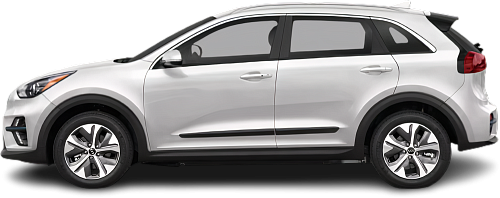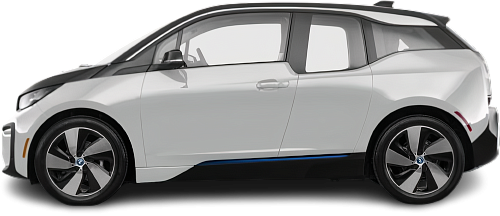Global EV Comparison: Kia Niro EV Standard Range vs BMW i3 BEV 120 Ah
Struggling to Decide? Let AI Help!
Your AI Summary Is Ready!
General Info
Since both vehicles have been discontinued, they are now only available on the used car market. You can get the Kia Niro EV Standard Range (2019-2022) for as low as €17885, while the BMW i3 BEV 120 Ah (2018-2022) begins at €17590.
The Kia Niro EV Standard Range (2019-2022) is a SUV, whereas the BMW i3 BEV 120 Ah (2018-2022) is a Hatchback.
| Property | Kia Niro EV Standard Range | BMW i3 BEV 120 Ah |
|---|---|---|
| Years of Production | 2019-2022 | 2018-2022 |
| Current Status | Discontinued | Discontinued |
| Country of Manufacture | South Korea | Germany |
| Body Style | SUV | Hatchback |
| Market Availability | EU | EU, USA |
| Price Europe (Used) | €17885 | €17590 |
| GCC Score | 5.2 | 5.3 |
Range and Efficiency
Even though the Kia Niro EV Standard Range (2019-2022) has a larger battery, the BMW i3 BEV 120 Ah (2018-2022) higher energy efficiency results in a longer real-world driving range.
| Property | Kia Niro EV Standard Range | BMW i3 BEV 120 Ah |
|---|---|---|
| Range (EPA) | - Range (EPA) | 246 km |
| Range (WLTP) | 289 km | 308 km |
| Range (GCC) | 246 km | 255 km |
| Battery Capacity (Nominal) | 42 kWh | 42.2 kWh |
| Battery Capacity (Usable) | 39.2 kWh | 37.9 kWh |
| Efficiency per 100 km | 15.9 kWh/100 km | 14.9 kWh/100 km |
| Efficiency per kWh | 6.28 km/kWh | 6.73 km/kWh |
| Range and Efficiency Score | 5.8 | 6.1 |
Charging
Both vehicles utilize a standard 400-volt architecture.
The BMW i3 BEV 120 Ah (2018-2022) offers faster charging speeds at DC stations, reaching up to 50 kW, while the Kia Niro EV Standard Range (2019-2022) maxes out at 44 kW.
The BMW i3 BEV 120 Ah (2018-2022) features a more powerful on-board charger, supporting a maximum AC charging power of 11 kW, whereas the Kia Niro EV Standard Range (2019-2022) is limited to 7.2 kW.
| Property | Kia Niro EV Standard Range | BMW i3 BEV 120 Ah |
|---|---|---|
| Max Charging Power (AC) | 7.2 kW | 11 kW |
| Max Charging Power (DC) | 44 kW | 50 kW |
| Architecture | 400 V | 400 V |
| Charge Port | CCS Type 2 | CCS Type 2 |
| Charging Score | 4 | 5.2 |
Performance
The BMW i3 BEV 120 Ah (2018-2022) is rear-wheel drive, while the Kia Niro EV Standard Range (2019-2022) offers a front-wheel drive system.
The BMW i3 BEV 120 Ah (2018-2022) boasts greater motor power and accelerates faster from 0 to 100 km/h.
| Property | Kia Niro EV Standard Range | BMW i3 BEV 120 Ah |
|---|---|---|
| Drive Type | FWD | RWD |
| Motor Type | PMSM | PMSM |
| Motor Power (kW) | 100 kW | 135 kW |
| Motor Power (hp) | 134 hp | 181 hp |
| Motor Torque | 395 Nm | 250 Nm |
| 0-100 km/h | 9.8 s | 7.3 s |
| Top Speed | 155 km/h | 150 km/h |
| Performance Score | 3.1 | 3.3 |
Dimensions
The Kia Niro EV Standard Range (2019-2022) has a longer body, while the BMW i3 BEV 120 Ah (2018-2022) stands taller, offering a more elevated ride. Their widths are almost identical, so both offer a similar amount of shoulder room.
The Kia Niro EV Standard Range (2019-2022) boasts a more extended wheelbase.
| Property | Kia Niro EV Standard Range | BMW i3 BEV 120 Ah |
|---|---|---|
| Length | 4375 mm | 4011 mm |
| Width (with Mirrors) | - Width (with Mirrors) | 2039 mm |
| Width (w/o Mirrors) | 1805 mm | 1775 mm |
| Height | 1560 mm | 1598 mm |
| Wheelbase | 2700 mm | 2570 mm |
Cargo and Towing
The Kia Niro EV Standard Range (2019-2022) provides more cargo capacity, featuring both a larger trunk and more space with the rear seats folded.
Neither car is equipped with a frunk (front trunk).
Neither vehicle is officially rated for towing in in the EU.
| Property | Kia Niro EV Standard Range | BMW i3 BEV 120 Ah |
|---|---|---|
| Number of Seats | 5 | 4 |
| Curb Weight | 1646 kg | 1345 kg |
| Cargo Volume (Trunk) | 451 l | 260 l |
| Cargo Volume (Max) | 1405 l | 1100 l |
| Cargo Volume (Frunk) | - Cargo Volume (Frunk) | - Cargo Volume (Frunk) |
| Towing Capacity | - Towing Capacity | - Towing Capacity |
| Cargo and Towing Score | 5.5 | 4.3 |




